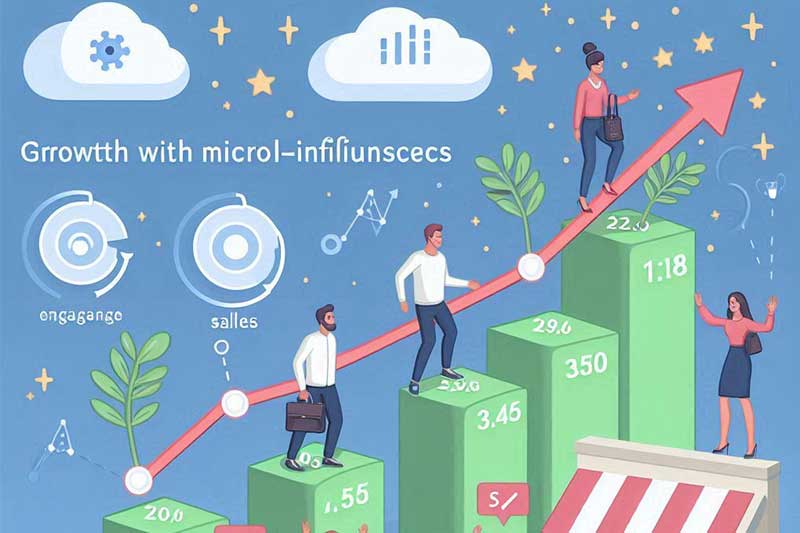As we enter 2025, micro-influencers have solidified their position as one of the most powerful and cost-effective tools in digital marketing. While influencer marketing has become a mainstream strategy for brands looking to expand their reach, the oversaturation of the influencer market has pushed businesses to seek out micro-influencers, individuals with smaller, yet highly engaged, niche audiences. These influencers may not have millions of followers like celebrities, but their authentic, close-knit communities allow them to deliver impactful, genuine interactions that drive results. In this blog, we’ll explore why micro-influencers are becoming central to marketing strategies in 2025, how businesses can effectively leverage their influence, and how micro-influencers help brands connect with targeted audiences in a way traditional advertising cannot match.
What Defines a Micro-Influencer?
A micro-influencer is typically defined as someone with a smaller social media following, generally between 1,000 and 100,000 followers. Unlike celebrities or macro-influencers, micro-influencers tend to focus on niche topics and maintain a more personal and authentic connection with their audience. Their influence stems from relatability, trust, and consistent engagement. While their follower count is lower, the quality of interaction they generate is often significantly higher.
Micro-influencers often specialize in specific areas such as fashion, health, beauty, fitness, tech, or food, making them ideal partners for brands targeting well-defined consumer segments. Their content typically feels more genuine and less commercialized, which helps position them as credible and trusted voices within their communities.
Why Micro-Influencers Drive Higher Engagement Rates
One of the most significant advantages of working with micro-influencers is the higher engagement rates they generate compared to larger influencers. According to research by the website SocialNative, micro-influencers typically achieve up to 60% higher engagement rates than macro-influencers. This is largely because their audience feels a closer, more personal connection, and their content is perceived as more authentic and relatable.
Micro-influencers also tend to interact more directly with their followers—replying to comments, liking posts, and starting conversations. This hands-on approach creates a genuine sense of community, leading to deeper, more meaningful engagement from followers who are more likely to trust and act on their recommendations. If you're curious about how to leverage digital channels to enhance audience engagement, understanding what is digital marketing is a great place to start.

Building Authentic Connections with Targeted Audiences
Building genuine and close connections with their followers is a cornerstone of micro-influencer marketing success. Micro-influencers are seen as approachable and relatable, often sharing personal experiences, behind-the-scenes moments, and honest opinions. These real and trustworthy interactions foster a level of connection that celebrities and macro-influencers often struggle to achieve.
For brands, this sense of authenticity translates into more effective marketing. When a micro-influencer recommends a product, their audience is more likely to believe and act on it because it feels like a sincere suggestion rather than a paid promotion. Their content often aligns naturally with the lifestyles, interests, and values of their followers, making their endorsements both credible and influential.
Cost-Effectiveness: Maximizing ROI with Micro-Influencers
One of the most significant benefits of partnering with micro-influencers is the cost-effectiveness of their campaigns. Compared to celebrities or influencers with millions of followers, micro-influencers are often much more affordable, making them an ideal choice for businesses with limited marketing budgets. Despite their lower fees, micro-influencers often deliver better value in terms of ROI, as their smaller but more engaged audiences are highly receptive to their content.
Brands can run multiple campaigns with several micro-influencers for the same price it would cost to work with one macro-influencer. This approach not only reduces costs but also allows businesses to diversify their strategy by reaching different audience segments.
Leveraging Niche Communities for Brand Advocacy
Leveraging niche communities has become a powerful strategy for brand advocacy in today's digital landscape. Micro-influencers excel at cultivating and engaging these tightly focused groups. Their deep expertise in specific interests or industries earns them credibility and trust from their audience. Because these niche communities are highly engaged and unified by common values or needs, they offer fertile ground for precisely targeted marketing.
For brands, partnering with micro-influencers allows for meaningful connections with audiences who are genuinely interested in their products or services. These influencers are viewed as reliable, relatable sources of information, making them highly effective advocates for your brand.
Crafting Compelling Campaigns with Micro-Influencer Partnerships
Crafting compelling micro-influencer campaigns goes beyond simply selecting the right individuals. Brands must design campaigns that genuinely resonate with both the influencer and their audience. This involves giving influencers the creative freedom to produce content that feels authentic and aligns with their unique style, rather than imposing rigid guidelines.
Collaboration is key—brands should work closely with micro-influencers to develop ideas that integrate naturally into their existing content. The most successful campaigns often feature creative, user-generated content that highlights the product or service in a way that feels organic and true to the influencer’s voice.

Measuring Success: Key Metrics for Micro-Influencer Campaigns
Measuring the success of a micro-influencer campaign involves tracking a combination of quantitative and qualitative key performance indicators (KPIs). While engagement metrics such as likes, shares, and comments offer valuable insights, the ultimate goal is to assess tangible business outcomes like increased sales or website traffic.
Additionally, evaluating the campaign’s effect on brand awareness and customer sentiment is crucial. Indicators such as brand mentions, hashtag usage, and influencer-generated content help measure how well the campaign resonates with the target audience and strengthens brand positioning.
Case Studies: Brands Thriving with Micro-Influencer Strategies
Many forward-thinking brands have already leveraged micro-influencer marketing to achieve remarkable success. A standout example is Daniel Wellington, the minimalist watch brand that built its global presence primarily through collaborations with thousands of micro-influencers. By focusing on authentic, user-generated content and avoiding costly celebrity endorsements, the company significantly expanded its reach while keeping acquisition costs low.
Another strong case is Glossier, a beauty brand that placed micro-influencers at the heart of its marketing strategy. By forming close relationships with beauty bloggers and content creators who had strong engagement with niche audiences, Glossier cultivated a loyal community that fueled its rise to one of the most talked-about skincare and cosmetics brands.
These examples clearly illustrate how micro-influencer partnerships, when done strategically, can deliver measurable growth in brand awareness, community engagement, and ultimately, sales.
Conclusion: Embracing Micro-Influencers for Sustainable Growth In 2025, micro-influencers have emerged as one of the most effective and accessible tools in digital marketing, offering brands a way to build genuine, cost-efficient, and precisely targeted campaigns. Their power lies in deep audience trust, high engagement, and the ability to reach tightly defined communities that align with specific brand goals.
As more companies recognize this potential, the key to lasting success will be prioritizing authenticity, nurturing long-term influencer relationships, and making data-informed decisions. Brands that invest in these strategies will not only maximize the ROI of their influencer campaigns but also position themselves ahead of the curve in an increasingly competitive digital landscape.
Book your free consultation with HDM today at +971 562 601 368 and let’s grow your brand together.
read more, Digital Marketing vs Traditional Marketing
FAQ
- What is the difference between a micro-influencer and a macro-influencer?
A micro-influencer typically has between 1,000 and 100,000 followers and focuses on niche topics. They have higher engagement rates and build stronger, more authentic connections with their audience, while macro-influencers have larger followings but often lower engagement rates.
- How do I find the right micro-influencer for my brand?
To find the right micro-influencer, consider factors like their audience demographics, engagement rates, content style, and whether their values align with your brand. Use influencer marketing platforms or manually search on social media for influencers who match your brand’s goals.
- How can I measure the success of my micro-influencer campaigns?
Track KPIs such as engagement rates, conversions, website traffic, and brand mentions. Use tools like Google Analytics, social media insights, and influencer marketing platforms to gather data and measure the effectiveness of your campaigns.
- Are micro-influencer campaigns cost-effective?
Yes, micro-influencer campaigns are often more cost-effective than working with macro-influencers or celebrities. Micro-influencers charge lower fees and can offer higher engagement rates, making them an excellent option for brands on a budget.




